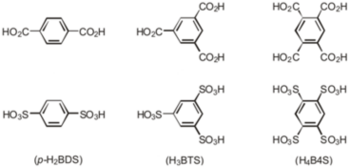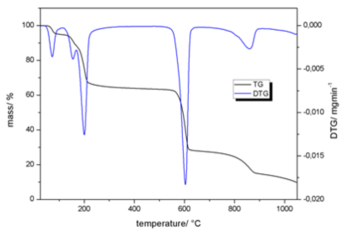Target of this project which is done in cooperation with the working group of Prof. Christoffers (Organic chemistry, University of Oldenburg) is the synthesis of novel oligosulfonic acids and their application in the synthesis of functional compounds. In contrast to the rampant oligo carboxylic acids it was mandatory to develop and optimize synthetic routes to the respective sulfo analogues (Fig. 1). With the help of these new sulfonic acids complex structures with different architectures and functionalities should be synthesized.

Fig. 1: Examples for the sulfo analogues of rampant carboxylic acids

Fig. 2: Molecular dimer of the zinc salt of the diphenylbutadiindisulfonic acid, H2DBS
The structures differ concerning the dimensionality of their linkage. Beside molecular strucutures (e.g. dimers) (Fig. 2), chainlike coordination polymers (linear, angulated, and helical chains, double strands, ladders and bands), layer type compounds and three-dimensional linkage should be achieved (Fig. 3 above). The functionalities of these compounds results from their constitution and the metals used. For lower dimensional compounds cooperative phenomena, e.g. magnetic coupling, are of particular interest. The three-dimensional compounds should act as metal organic frameworks (MOFs) with high thermal stability. The deomposition temperatures of the investigated sulfonates are 200-300 °C above the decomposition temperatures of the respective carboxylates (Fig. 3 bottom). The actual research focuses on the synthesis of compounds with spectroscopic and magnetic relevant metals (lanthanides, transition metals) and the investigation of sorption properties of the solvent free sulfonates.


Fig. 3 Layer structure of [Zn(BDS(DMF)2] (BDS = 1,4-benzene disulfonic acid) (top) and thermal decomposition of the compound (bottom).

Abb. 1: Beispiele für die von uns dargestellten Sulfo-Analoga gängiger Carbonsäuren

Abb. 2: Molekulares Dimer des Zinksalzes der Diphenylbutadiindisulfonsäure, H2DBS
Die Architekturen unterscheiden sich hinsichtlich der Dimensionalität der in ihnen auftretenden Verknüpfungen. Neben molekularen Strukturen (z. B. Dimeren) (Abb. 2) sollen kettenförmige Koordinationspolymere (lineare, gewinkelte und helikale Ketten, Doppelstränge, Leitern und Bänder), schichtartige Verbindungen und dreidimensionale Vernetzungen erzeugt werden (Abb. 3 oben). Die Funktionalität der Verbindungen resultiert aus ihrem Aufbau und den eingesetzten Metallen. Für die niederdimensionalen Verbindungen sind insbesondere kooperative Phänomene, z. B. magnetische Kopplungen interessant. Die dreidimensionalen Verbindungen sollen als metall-organische Gerüstverbindungen (MOFs) mit hoher thermischer Beständigkeit fungieren. Die Zersetzungstemperaturen der untersuchten Sulfonate liegen dabei 200-300 °C höher als jene der entsprechenden Carboxylate (Abb. 3 unten). Zurzeit sind wir mit der Synthese von Verbindungen mit spektroskopisch und magnetisch relevanten Metallen beschäftigt (Lanthanide, Übergangsmetalle) und untersuchen die Sorptionseigenschaften solvensfreier Sulfonate.


Abb. 3 Schichtstruktur von [Zn(BDS(DMF)2] (BDS = 1,4-Benzoldisulfonsäure) (oben) und thermischer Abbau der Verbindung (unten).